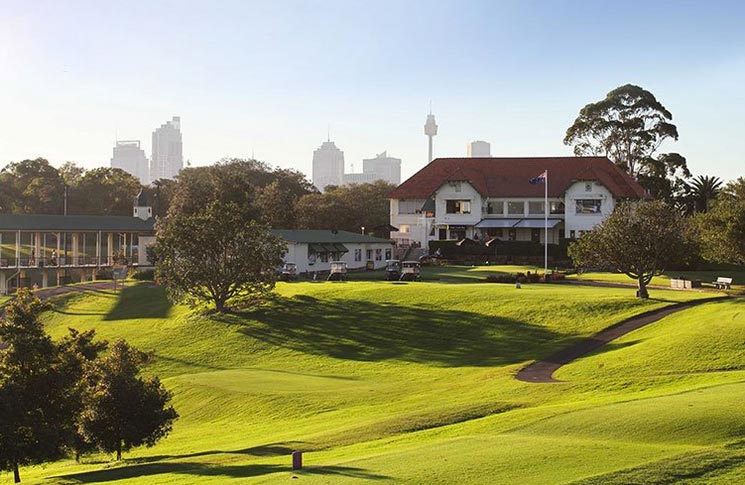BACKYARD greens have surged in popularity in Australia over the past couple of years. What was once every avid golfer’s dream has become increasingly attainable thanks to a host of local companies offering installation of synthetic putting surfaces.
But all these pale in comparison to Sydney entrepreneur Craig Perkins’ latest venture. The Terrey Hills Golf & Country Club member may have just built the most impressive backyard green in golf – an exact replica of TPC Sawgrass’ famous 17th hole that’s set to transform his 200-acre horse stud in the New South Wales Southern Highlands into a quirky stay-and-play golf destination.

Everything begins with an idea, or so they say, and for Perkins the idea of imitating the world’s greatest island-green par 3 came about when one of the dams on his Woodlands property, eight kilometres north-west of Mittagong, needed urgent repair.
“I stood back and looked at it and thought, That would make a fantastic island green,” recalls Perkins, a golf tragic who travels back and forth between his Southern highlands farm and family home at Ingleside on Sydney’s northern beaches.
“We built the green as a bit of a fun experiment but through poor workmanship, the thing collapsed shortly after. So I said if I’m going to do this again, I’m going to do it properly.”
Perkins engaged renowned course architect Bob Harrison, award-winning Avondale Golf Club superintendent David Warwick and a team of surveyors to carefully map out Pete Dye’s famous island green with pinpoint accuracy. The green’s size, shape, distance and angle of attack from the tee were all measured to the number with precision, complete with the recognisable wooden-sleeper wall, front bunker and player walkway at the rear.

Through trial and error – “and not a lot of change out of $100,000” – Perkins admits the finished product, the second time around, has left everyone amazed at its likeness to the real thing.
“The only real difference is I’ve added three additional tees for some variety, ranging from 120 metres to 160m,” adds Perkins, who employs a local greenkeeper to maintain the hole.
“We left absolutely nothing to the imagination during the construction process. We even had connections from TPC Sawgrass on the phone consulting with us. It doesn’t get any more realistic than that!”
While drought conditions have left water levels lower than normal, consequently exposing more rock and bank than intended, Perkins says when the water returns, the replica hole – one of Australia’s only legitimate island greens – will be identical to the real McCoy.

And while most backyard holes are built for personal satisfaction, Perkins intends opening “TPC Woodlands” (named after the postcode it falls under, not the Texas-based country club on the US PGA Tour) to the world, launching a bed-and-breakfast facility for tourists passing through the popular wine region.
“Visitors who play here won’t have to worry about losing their own golf balls either, as we have special floating balls,” says Perkins. “Everyone who comes here can take aim at TPC Woodlands without fear.”
Once asked to describe his thought process around the design of the 17th at TPC Sawgrass, the legendary Dye replied: “I don’t think any of us really thought of the 17th hole. It just kind of arrived.”
After experiencing Australia’s version of the masterpiece, you’ll keep coming back to hit balls without much thought, too.
To book your stay at TPC Woodlands, e-mail [email protected].
On the eve of the Players Championship at TPC Sawgrass, we asked some of Australia’s leading golf course architects to step up and have their shot at a timely hit-or-miss question…
Does Golf Need More Island Greens?
Michael Clayton (co-designer of Barnbougle Dunes, No.4 in Australia)
“It’s entertaining at The Players but the world is filled with great short holes where the designers gave players a way to make an easy bogey. The seventh at Barnbougle is a much harder green to hit and a much more difficult hole but with a way to make 4. It’s holes like that we should be encouraging. In Australia we have some of the great short holes – none of which had to resort to imitating the principles of the 17th at TPC Sawgrass – which should have been left as a one-off and not something to be envied or copied.”
Darius Oliver (co-designer of Cape Wickham Links, No.3 in Australia)
“I’m not really a fan of island greens. I think the original has its place as an exciting penultimate hole specifically built for a tournament venue, but most of the island greens I’ve seen struggle to match TPC Sawgrass in either style or substance. Strangely, most are too forgiving for the concept to work really well, possibly because designers are nervous about average golfers having somewhere to bail out. The Hidden Valley version in Victoria is fairly typical of what I’ve seen around the world: cute idea but only poorer players are really nervous about the carry.”
Ross Perrett (designer of Hamilton Island, No.31 in Australia)
“We are not huge fans of island greens but we have often been asked to design them. We prefer ‘peninsula’-type greens, which give the average golfer an alternative way of playing the hole. For example at Hope Island the project masterplanners wanted an island green for the penultimate green (17th) but we negotiated to make it a peninsula hole with a generous bail-out area.”
Neil Crafter (consulting architect of Kooyonga, No.25 in Australia)
“Island greens are a very 1980s kind of feature. I’ve never built one and doubt I ever will. It’s real death or glory stuff though, no real strategy other than hit the green or suffer the consequences.”



